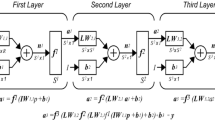Abstract
In this paper, a modified method for landslide prediction is presented. This method is based on the back-propagation neural network (BPNN), and we use the combination of genetic algorithm and simulated annealing algorithm to optimize the weights and biases of the network. The improved BPNN modeling can work out the complex nonlinear relation by learning model and using the present data. This paper demonstrates that the revised BPNN modeling can be used to predict and calculate landslide deformation, quicken the learning speed of network, and improve the predicting precision. Applying this thinking and method into research of some landslide in the Three Gorges reservoir, the validity and practical value of this model can be demonstrated. And it also shows that the dynamic prediction of landslide deformation is very crucial.




Similar content being viewed by others
Explore related subjects
Discover the latest articles, news and stories from top researchers in related subjects.References
Huang ZQ. The nonlinear theories of landslide analysis and application. Zhengzhou: Yellow River Conservancy Press; 2005.
Gluege S, Hamid OH, Wendemuth A. A simple recurrent network for implicit learning of temporal sequences. Cogn Comput. 2010;2(4):265–71.
Subirats JL, Jerez JM, Gomez I. Multiclass pattern recognition extension for the new C-Mantec constructive neural network algorithm. Cogn Comput. 2010;2(4):285–90.
Rao S, Aleksander I. A position identification and path labelling mechanism for a neural model of visual awareness. Cogn Comput. 2010;2(4):360–72.
Indiveri G, Chicca E, Douglas RJ. Artificial cognitive systems: from VLSI networks of spiking neurons to neuromorphic cognition. Cogn Comput. 2009;1(2):119–27.
Garagnani M, Wennekers T, Pulvermueller F. Recruitment and consolidation of cell assemblies for words by way of Hebbian learning and competition in a multi-layer neural network. Cogn Comput. 2009;1(2):160–76.
Haikonen POA. The role of associative processing in cognitive computing. Cogn Comput. 2009;1(1):42–9.
Gros C. Cognitive computation with autonomously active neural networks: an emerging field. Cogn Comput. 2009;1(1):77–90.
Melchiorre C, Matteucci M, Azzoni A, Zanchi A. Artificial neural networks and cluster analysis in landslide susceptibility zonation. Geomorphology. 2008;94:379–400.
Pradhan B, Lee S. Regional landslide susceptibility analysis using back-propagation neural network model at Cameron Highland, Malaysia. Landslide. 2010;7:13–30.
Lee S, Ryu JH, Kim IS. Landslide susceptibility analysis and its verification using likelihood ratio, logistic regression, and artificial neural network models: case study of Youngin, Korea. Landslides. 2007;4:327–38.
Pradhan B, Lee S. Landslide susceptibility assessment and factor effect analysis: backpropagation artificial neural networks and their comparison with frequency ratio and bivariate logistic regression modeling. Environ Model Softw. 2010;25:747–59.
Gao W, Feng X. Study on displacement predication of landslide based on grey system and evolutionary neural network. Rock Soil Mech. 2004;25(4):514–7.
Neaupane KM, Achet SH. Use of backpropagation neural network for landslide monitoring: a case study in the higher Himalaya. Eng Geol. 2004;74:213–26.
Jaroudi E, Makhoul J. A new error criterion for posterior probability estimation with neural nets. In: Proceedings of iteration joint conference on neural networks; 1990, pp. 185–192.
Ducker H, Cuny YL. Improving generalization using double back propagation. IEEE Trans Neural Netw. 1992;3(6):991–7.
Mayoraz F, Vulliet L. Neural networks for slope movement prediction. Int J Geomech. 2002;2(2):153–73.
Das SK, Basudhar PK. Prediction of coefficient of lateral earth pressure using artificial neural networks. Bundle A Electron J Geotech Eng. 2005; 10.
Holland J. Adaptation in natural and artificial systems. University of Michigan Press; 1975.
Zhu QM. A back propagation algorithm to estimate the parameters of non-linear dynamic rational models. Appl Math Model. 2003;27:169–87.
Arifovic J, Gencay R. Using genetic algorithms to select architecture of a feed forward artificial neural network. Phys A. 2001;289:574–94.
Harri N, Teri H, et al. Evolving the neural network model for forecasting air pollution time series. Eng Appl Artif Intell. 2004;17:159–67.
Li SJ, Li Y. A GA-based NN approach for makespan estimation. Appl Math Comput. 2007;185:1003–14.
Kirkpatrick S, Gerlatt JCD, Vecchi MP. Optimization by simulated annealing. Science. 1983;220:671–80.
Rumelhart DE, Hinton GE, McClelland JL. A general framework for parallel distributed processing: explorations in the microstructure of cognition, vol. 1. Cambridge: MIT Press; 1986.
Hornik KM, Stinchcombe M, White H. Multilayer feedforward networks are universal approximators. Neural Netw. 1989;2:359–66.
Agrawal G, Frost JD, Chameau JLA. Data analysis and modeling using artificial neural network. In: Proceedings of XIII international conference of soil mechanics and foundation Engineering, New Delhi; 1994, p. 1441–1444.
Simpson PK. Architecture neural system-foundation, paradigm, application and implementation. New York: Pergamon Press; 1990.
Acknowledgments
The work is supported by the Natural Science Foundation of China under Grant 60974021, the 973 Program of China under Grant 2011CB710606, the Fund for Distinguished Young Scholars of Hubei Province under Grant 2010CDA081, and the Specialized Research Fund for the Doctoral Program of Higher Education of China under Grant 20100142110021.
Author information
Authors and Affiliations
Corresponding author
Rights and permissions
About this article
Cite this article
Chen, H., Zeng, Z. Deformation Prediction of Landslide Based on Improved Back-propagation Neural Network. Cogn Comput 5, 56–62 (2013). https://doi.org/10.1007/s12559-012-9148-1
Received:
Accepted:
Published:
Issue Date:
DOI: https://doi.org/10.1007/s12559-012-9148-1




